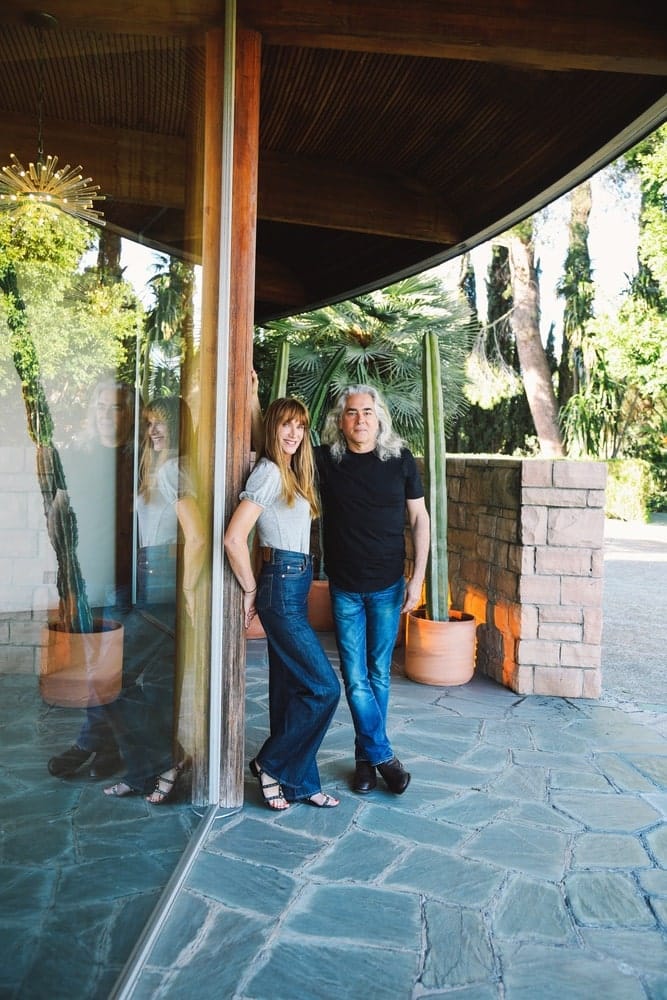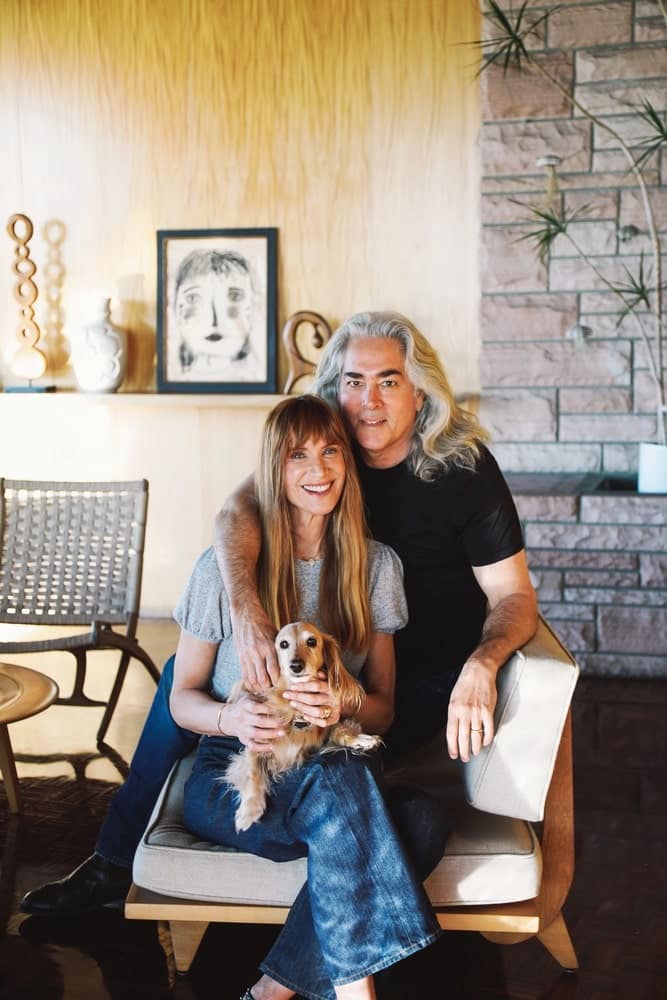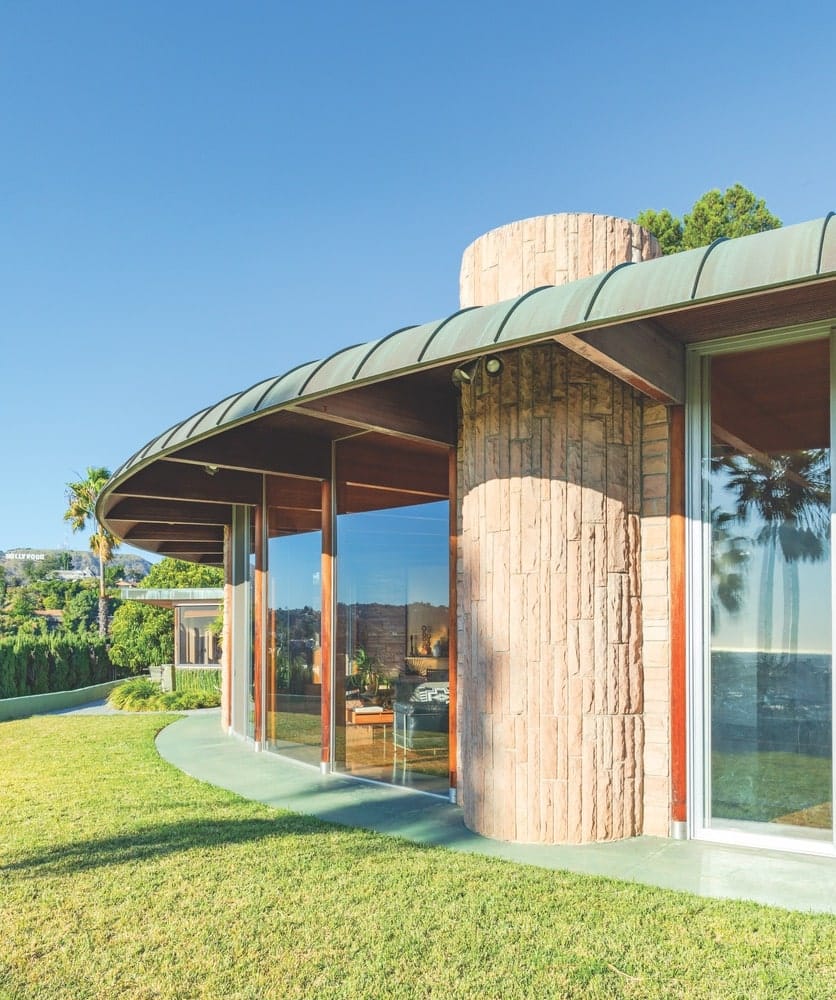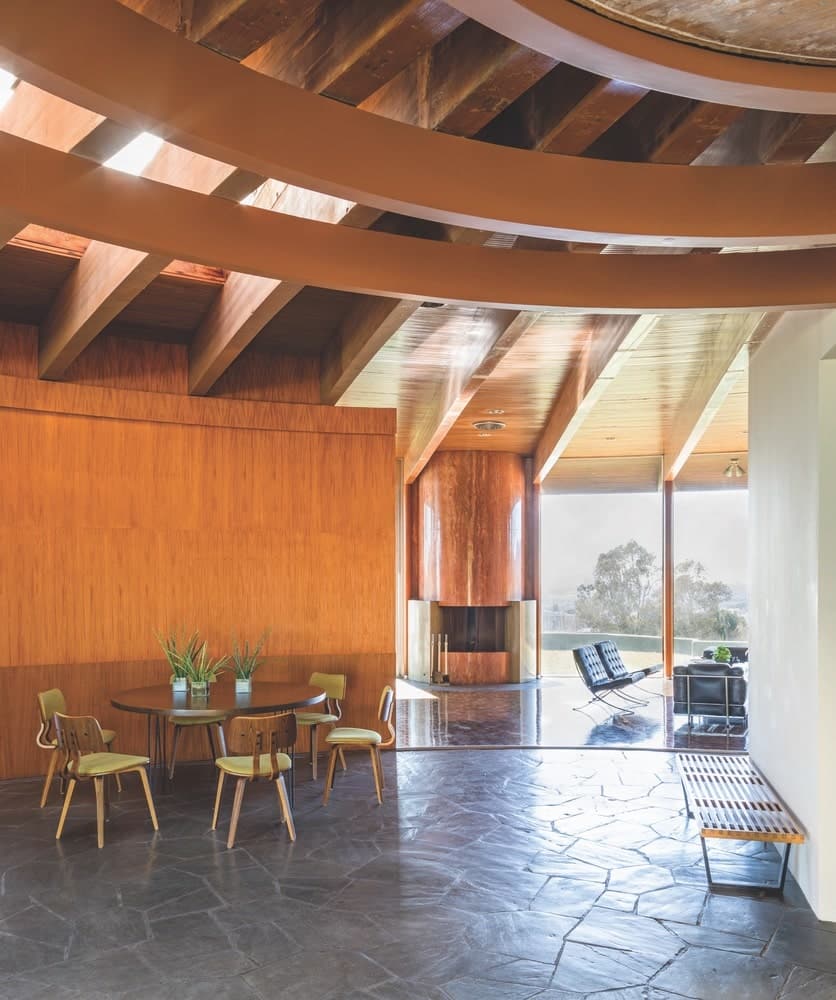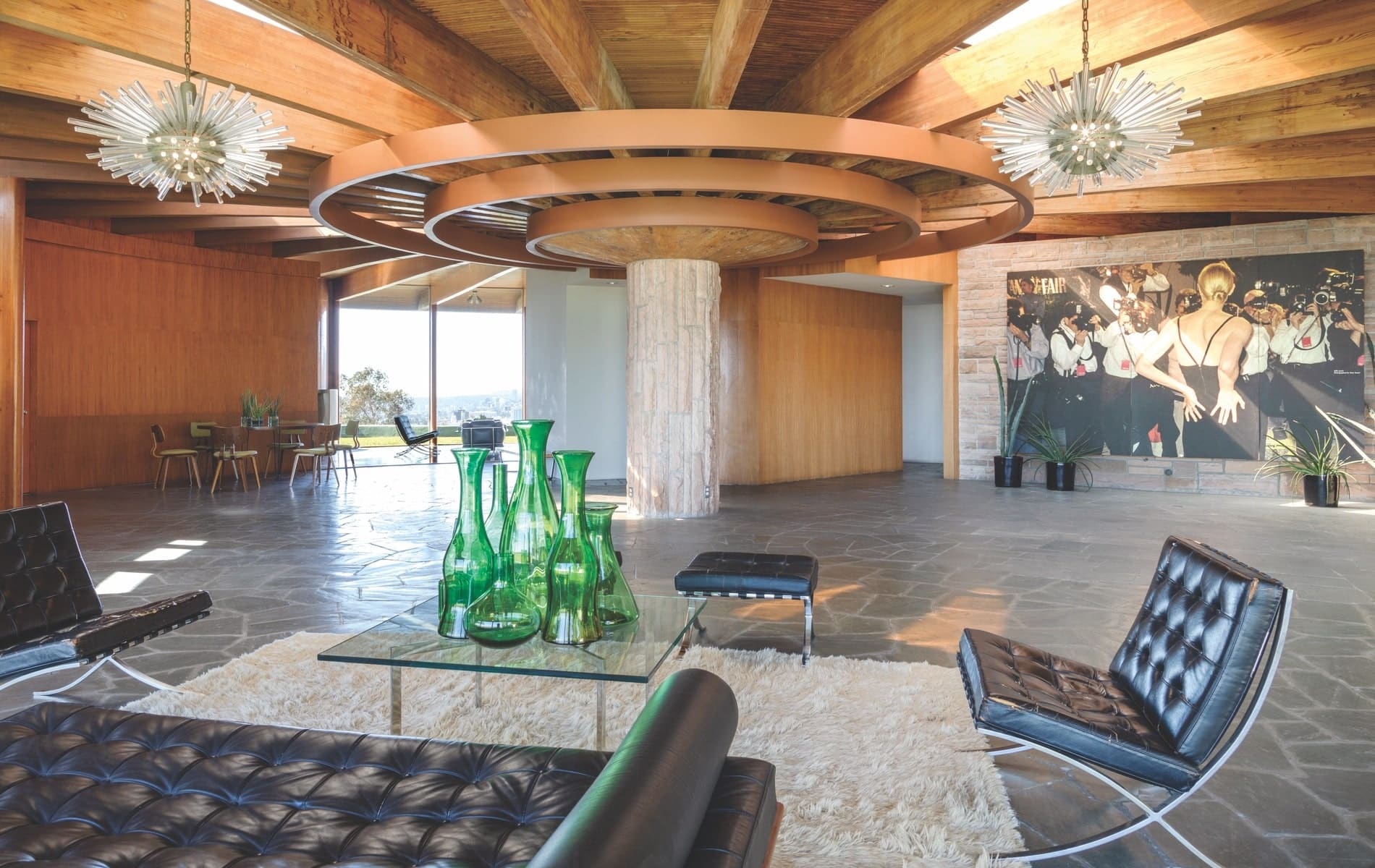
vie-magazine-lautner-house-hero-min
Kelly and Mitch call this “the lobby.” The spacious main entry area features a mural photograph by Peter Beard of Kelly at the 1989 premiere of Drugstore Cowboy. | Photo by Sara Essex Bradley
An Architectural Masterpiece
A Star Among Stars
By Anthea Gerrie
An entertaining space expansive enough for five hundred people is an unusual attribute for any family home, but almost unheard of in a two-bedroom residence. However, the Harvey house, perched on a hilltop high above Hollywood, is extraordinary by any standards.
“It was built by John Lautner, the man Frank Lloyd Wright called ‘the world’s second-greatest architect,’ for aluminum magnate Leo Harvey,” says actress Kelly Lynch, who has lived in this very special aerie for twenty-one years with her husband, Florida-born writer and producer Mitch Glazer.
- Actress Kelly Lynch and her husband, writer and producer Mitch Glazer, bought the Harvey house in the late 1990s. | Photo by Amy Dickerson
- Kelly and Mitch share their beautifully preserved home with their adorable furry companion, the Ram. They plan to continue updating the house, starting with the kitchen. | Photo by Amy Dickerson
The couple has reveled in the never-ending project of restoring the once-derelict, partially degraded masterpiece to its former glory over the past two decades. Kelly admits friends tried to deter them from racing to buy a ruin which, on the surface, looked like a potentially bottomless money pit. But their passion for California’s wealth of modernist architecture and the opportunity to experience it firsthand would not be denied. “We just love living here and sharing Lautner’s vision with others,” explains the star of the cult classic film Drugstore Cowboy and the 2000 reboot of Charlie’s Angels, who looks even more sensational at sixty than when she first became a marquee name at half that age.
The Harvey house was one of the first commissions for Wright’s now-famous student, who got the gig because he was known to be a superb engineer. “This site wasn’t flat—it was a mountaintop and had to be flattened to build on,” explains Kelly. “Leo Harvey was one of the first to establish a home in these hills, and he had heard about Lautner’s expertise in building on difficult sites.”
It was a time, she explains, when Lautner and his family were splitting a large loaf of bread and an outsize can of beans for dinner “because that’s all they could afford in the late 1940s. When Leo Harvey arrived with a $250,000 check for the commencement, they called him the architectural angel!”
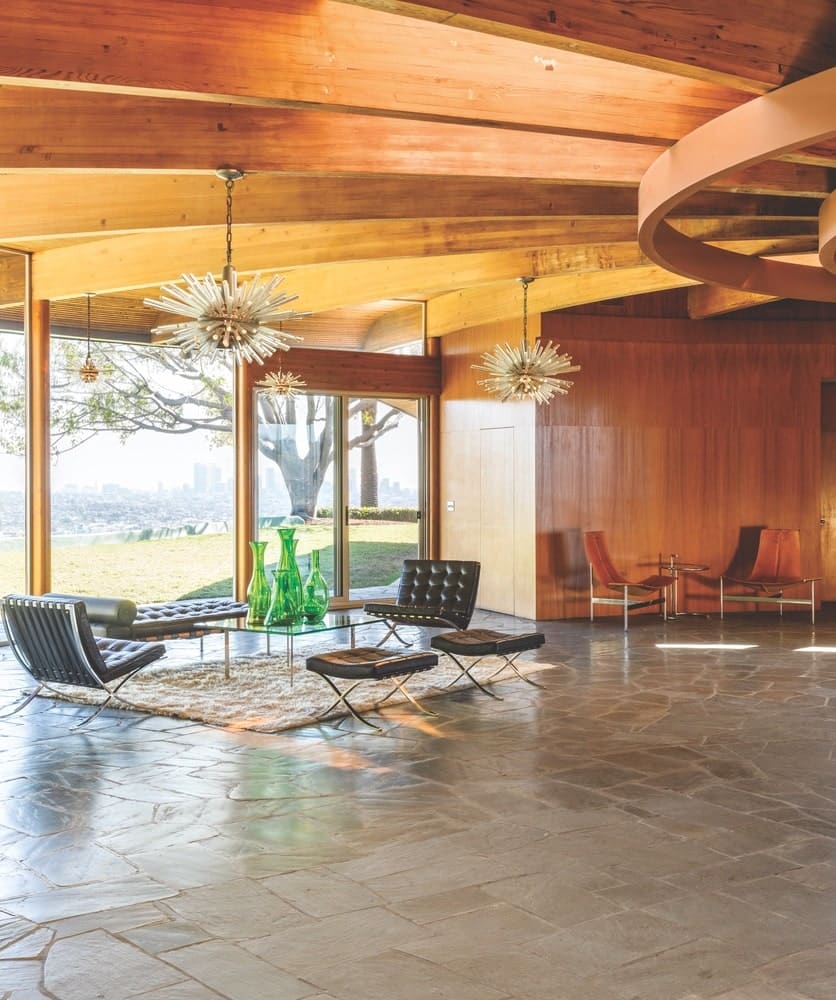
The main part of the home is a circular hub with rich wood partitions creating separate spaces. Its breathtaking views include the Los Angeles skyline, the Hollywood Sign, and the Griffith Observatory. | Photo by Sara Essex Bradley
That’s nearly twice as much as the second owners bought the house for in 1978, doing it no favors. “It was in bad shape,” Kelly shares. “The second owner never understood the architecture and started adding sheetrock additions that were never finished, leaving dangling wires. We had to look at the plans to see exactly what the house was originally and take everything away to get to what was there. Friends were throwing themselves in front of us telling us we could not do this.”
But that did not stop the couple paying ten times as much for the house just twenty years later, when they outbid Leonardo DiCaprio to secure their $1.5 million purchase. “We knew what we had ahead of us—that we would have to put another $1.5 million into the house,” Kelly admits, “so we were very nervous, but we really wanted it. We are both preservationists, and although it looked a mess when we got it, we knew it was between Leo and us or the house being torn down.”
“We knew what we had ahead of us—that we would have to put another $1.5 million into the house. So we were very nervous, but we really wanted it.”
The thought of such a jewel, which overlooks all of Los Angeles and is bookended by views of the Griffith Observatory on one side and the iconic Hollywood Sign on the other, being demolished was really what drove Kelly and Mitch to take their giant leap into restoring it to its former glory.
The house is one of a series Lautner created in LA, his most famous being the Chemosphere house overlooking Beverly Hills. Each home has a central pillar supporting what looks like an enormous spoked wooden wheel as the ceiling; in the Harvey house, this “wow” feature is now in an enormous foyer. Originally it was an indoor-outdoor area, but it was closed off in the 1960s to create a larger entertaining space with glass walls that span a giant semicircle. “We call it the lobby—it’s kind of a joke because it’s such a big space,” laughs Kelly. The couple hosted a party here for the late legendary photographer of modernist architecture Julius Shulman, and Kelly herself is celebrated in a huge mural photograph showing her at the premiere of Drugstore Cowboy—“a rare moment of glamour in what is often a far from glamorous industry,” she laughs drily.
- The couple has spent a considerable amount of time and money restoring the home while preserving the integrity of its original design. | Photo by Sara Essex Bradley
- The Harvey house in the Hollywood Hills, designed by John Lautner in the early 1940s, is a stunning example of midcentury modern and organic architecture. | Photo by Sara Essex Bradley
A delightful living room overlooking the city is floored in the original parquet laid seventy years ago, and, just for fun, the owners kept the original midcentury television set and hi-fi equipment built into the satinwood wall fixtures. Although it’s also original, the ornate and expensive finish on the fireplace was not the choice of Lautner, who eschewed extravagant ornament. “But Leo Harvey was somewhat ostentatious and insisted on cladding the fireplace in marble,” laughs Kelly.
The two bedrooms, with their magnificent views, were designed as his-and-her master suites for the Harveys. Each has the feel of an ocean-liner stateroom, thanks to walls clad in floor-to-ceiling padauk wood. In the art deco–style bathrooms, Harvey, the metal magnate, added his design imprint with built-in circular mirrors and innovative aluminum fixtures.
The color scheme in the bathroom is the same salmon pink and mint green so indicative of the Beverly Hills Hotel; Kelly went to great lengths to research the exact shades. “I was actually prowling in the hotel shrubbery trying to color match the paint until a guard told me I couldn’t do that!” she laughs.
“But as proud preservationists, we love this work and how much enjoyment these houses bring to all who see them, as well as bring to us who actually get to live the dream.”
The carpet has been replaced throughout the home by handsome black slate floors, with the exception of Mitch’s office, which is outfitted in cork. There are pictures on the wall recalling the 1950s architecture of Miami, where his father worked as an engineer on many noted construction projects, and Mitch confesses he was “steeped in architecture as a kid.” His own construction projects have included an astonishing $14 million hotel mock-up created for Magic City, the Golden Globe–nominated TV show set in the modernist Miami of the late 1950s. “We built this fake hotel on stages out near the airport, and a couple of people actually tried to check in,” he jokes.
The handsome ficus tree outside looks as though it has been on the site forever, but it was actually planted by Kelly and Mitch. Past it, the views are outstanding—a constant reminder of why Leo Harvey thought it was worth the cost of slicing off a mountaintop to perch the house within view of two great Los Angeles icons (the observatory and the famous hillside sign).
Naturally, there is a swimming pool. It’s small, as it was adapted from a therapy pool installed for Mrs. Harvey when she was recovering from a stroke, and it cannot be enlarged because of building regulations. Still, the wraparound lawn, which is used as an outdoor entertaining space, holds a newer secret—a jungle-like tropical garden far below.
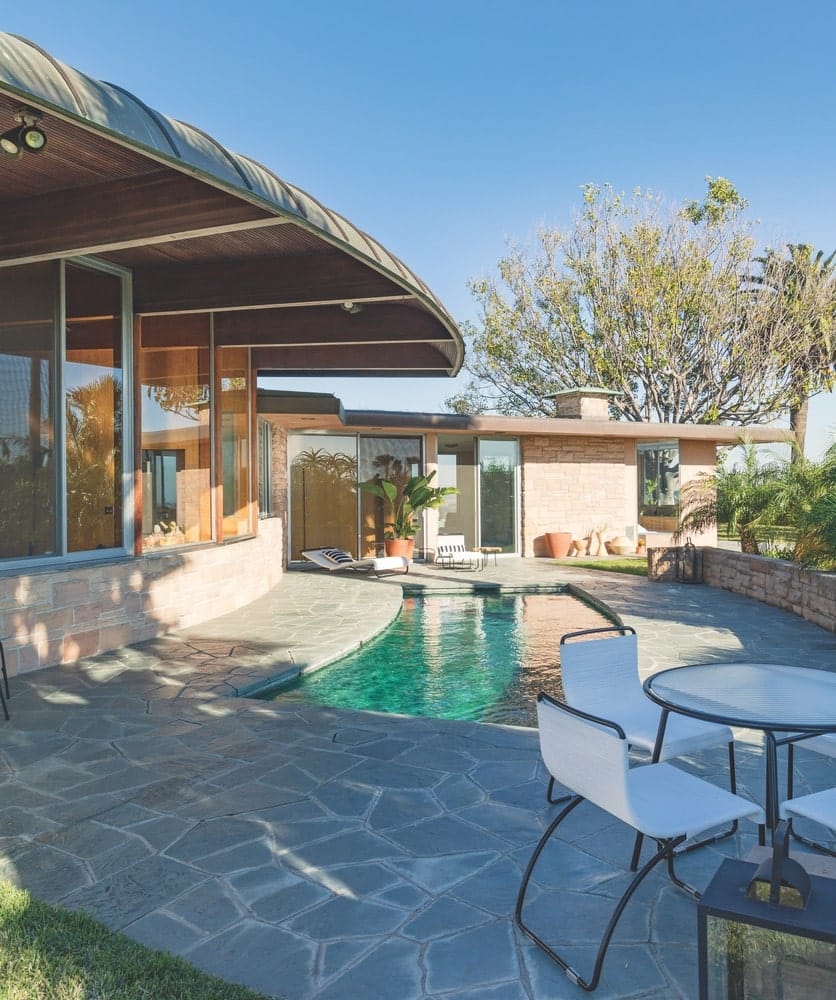
The small swimming pool was once a therapy pool built for Mrs. Harvey after she suffered a stroke. It is now a quiet place to relax and enjoy the view. | Photo by Sara Essex Bradley
There is always going to be plenty to do in this house, where the original all-wood galley kitchen, separated from the living room by a serving hatch, is too small to be functional for a modern family. A much larger kitchen—with 1970s cabinetry installed by the previous owners—and an adjacent family room are buried in the interior of the house. These will be Mitch and Kelly’s next projects for renovation.
Next, but not last, the homeowners have acquired a residence in the rural California hinterland of Lone Pine. It was designed by another famous modernist architect, Richard Neutra. With two old properties requiring constant careful attention, Kelly and Mitch are veritably locked into a long-term labor of love. “But as proud preservationists, we love this work and how much enjoyment these houses bring to all who see them, as well as bring to us who actually get to live the dream,” says Kelly.
— V —
Anthea Gerrie is based in the UK but travels the world in search of stories. Her special interests are architecture and design, culture, food, and drink, as well as the best places to visit in the world’s great playgrounds. She is a regular contributor to the Daily Mail, the Independent, and Blueprint.
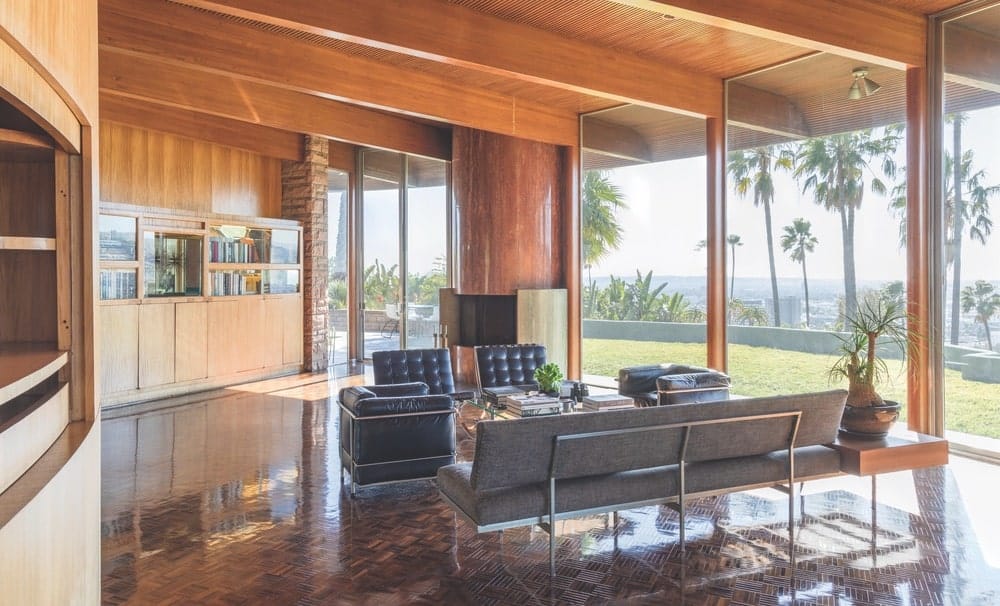
The Harvey house was listed on the National Register of Historic Places in 2016 for its significance as one of Lautner’s best examples of architecture from 1940 to 1944. | Photo by Sara Essex Bradley
Visit These John Lautner Designs in California
From time to time, the owners of Lautner’s amazing homes in Southern California open them for visits. The 1963 Sheats-Goldstein house—which has had extensive renovation and been featured in The Big Lebowski—has been promised as a future gift to the Los Angeles County Museum of Art. Tours will be allowed periodically by owner James Goldstein, still in residence. Visit JamesFGoldstein.com to learn more and take a virtual tour.
The Lautner Compound in Desert Hot Springs, California, is an ambitious resort project on six hundred acres that Lautner was commissioned to build in the desert in 1947. Although it was aborted after only four units were completed, they have been preserved and beautifully restored as vacation rental accommodations. The compound is also a popular venue for weddings. Check out TheLautner.com to learn more and see photos.
Share This Story!
KEEP UP WITH THE LATEST STORIES FROM VIE



